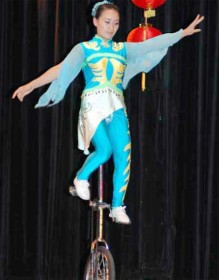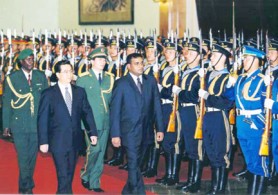The announcement of the appointment of an ambassador of the Cooperative Republic of Guyana to the People’s Republic of China was a bolt from the blue. Soon after the People’s Progressive Party Civic entered government in October 1992, it purged from office all the ambassadors who had been appointed by the People’s National Congress administration with one exception. The administration reopened its mission in New Delhi but, for nearly 17 years, never appointed an ambassador to Beijing. It was assumed that Guyana-China relations downgraded.

Professor David Dabydeen, who is to be the new ambassador, was professor at the Centre for Caribbean Studies at the University of Warwick where he specialised in 18th and 19th century Caribbean and Black British culture and history. He also served as the ambassador and permanent delegate to UNESCO since 1997. Will he be the man to move Guyana-China relations to a higher economic level?
China’s place in the global economy has changed dramatically over the past two decades and that country has become one of the most important global economic powerhouses of the new millennium. It has become a commercial, economic and financial world power and economic relations with China are a necessity, rather than an option, for developing countries such as Guyana. It is remarkable, therefore, that Guyana has not sought to employ economic diplomacy more vigorously in order to exploit its friendship to greater advantage to benefit from China’s growing technological strength.
This month marks the 38th anniversary of the establishment of diplomatic relations between the two states. The world was a different place at that time and it was regarded as a bold move and a major milestone in Guyana’s international relations and diplomatic history when diplomatic relations were established. Formal relations started only after a period during which the two states modified the perceptions and positions they had adopted towards each other prior to 1970.
The People’s National Congress administration had established diplomatic relations with Taiwan’s Republic of China which held a permanent seat in the UN Security Council. The People’s Republic of China, on the other hand, supported certain political groups – such as the so-called Marxist-Leninist Working People’s Vanguard Party and the Movement against Oppression – which were opposed to the government. Guyana resented China’s support as interference in this country’s internal affairs.

The Chinese ‘Great Proletarian Cultural Revolution’ which was launched in 1966 was petering out by 1971 and China’s support for its local anti-government proxies evaporated. The PNC Administration at this time was ready to switch its diplomatic relations. As a result, Guyana lent its support for the China’s bid to occupy the permanent seat in the Security Council. At the same time, of course, economic and diplomatic relations with Taiwan were terminated. The way was cleared of obstacles.
The PNC administration’s need to attract aid and investment, access ‘appropriate’ technology, increase exports and diversify markets propelled the new economic diplomacy. This was necessary to support its Second Development Plan, 1972-1976 and, from the start, it embarked on a pragmatic policy of economic cooperation with China.
The Guyanese and Chinese Governments soon found common ground. A Chinese Trade Mission visited George-town as early as August 1971 and, in November, a Guyanese mission visited Beijing. Prior to the establishment of formal diplomatic relations in June 1972, Guyana and China signed an Agreement on the Mutual Establishment of Commercial Offices in November 1971 and China opened its Commercial Office in Guyana in March 1972. China then opened its embassy in Guyana making Georgetown its first embassy among the English-speaking Caribbean states. Since then, the two states have enjoyed long-term and friendly relations marked by the frequent exchange of high-level visits.
Prime Minister Burnham visited China in March 1975 meeting Premier Zhou Enlai. During the visit, the two sides signed an Agreement on Economic and Technological Cooperation. Mr Burnham returned to China, this time as President, in June 1984, meeting Chinese President Li Xiannian, General Secretary Hu Yaobang, Chairman Deng Xiaoping and Acting Premier Wan Li. During the visit, the two sides signed five documents on economic cooperation, cultural exchange, the establishment of a joint commission on economic, trade, scientific and technological cooperation, transformation of the textile mill built with Chinese assistance, and the provision of cotton under loans by China. It was evident that the earliest objectives were economic in nature.
Following these early contacts, Beijing agreed to buy alumina, bauxite, wood and sugar. Guyana received an interest-free loan of G$52 M – repayable over 20 years with a 10-year moratorium – and entered a contract to import Chinese products. That was the start. Agreements were also reached for Chinese technicians to train Guyanese in rice expansion, cotton-growing and bricklaying – expertise required for what the administration then perceived to be its ‘Feed, Clothe and House’ the nation policy in accordance with the Second Development Plan. Diplomatic initiatives and economic interests proceeded hand in hand.
The People’s Progressive Party throughout the Cold War era had stuck stubbornly to Moscow’s international line and opposed the Guyana government’s relations with China. It was fiercely critical of China. Its official announcement on the 1974 China-Vietnam conflict, as an example of the dogmatic rhetoric of the day, stated “What is clear is that the world is witnessing…the first steps in the working out of the Chinese policy of expansionism and hegemonism in South-East Asia and the Far East – the policy which commenced nearly two decades ago.”
The PPP had not shed this mindset when it entered office in 1992 although there was no visible deviation from the PNC’s policies which had been in existence for the previous twenty years. Except for the removal and failure to replace, the resident ambassador, cordial relations continued. President Cheddi Jagan visited China in December 1993 and held talks with Chinese President Jiang Zemin. President Bharrat Jagdeo paid a state visit to China a decade later in March-April 2003, at the invitation of President Hu Jintao. The two sides signed an agreement on the protection of investment and an agreement on economic and technological cooperation.
Despite cordial ties, the absence of a Guyanese ambassador in Beijing has always been a diplomatic deficiency and economic relations plodded. The volume of trade between the two countries remained relatively small over the years. China mainly exported to Guyana in cash and provided goods under loans from the 1970s and these increased only gradually to include mainly industrial and agricultural implements, textiles and light industrial products over the past decade.
There have been some moderate incremental changes in economic relations but these have been patchy and episodic. As an example, representatives of the Jilin Provincial government delegation visited Guyana in April 2000 and opened consultations with the Guyana Forestry Committee on cooperation between Jilin Forestry Industry (Group) Co. and Guyana. Representatives of the China Import-Export Corporation of Aeronautical Technology also visited Guyana to launch the “Yun-12” aeroplane sales promotion in April 2001. After a joint flying demonstration of “Yun-12” aeroplane with the Guyana Defence Force, Chief of Staff Brigadier Michael Atherley signed a memorandum of understanding on the sale and purchase of the aircraft. Brigadier Atherley also paid an official friendly visit to China in October 2001. There have been visits of other high-level military delegations, donations of non-lethal equipment such as musical instruments and training of military officers.
Major projects in economic and technological cooperation between China and Guyana over the past decades have included agricultural cultivation and processing; brick-making and bicycle-assembling; the provision of a Bag-braiding plant, grain-processing equipment and the erection of the Bel-Lu Claybrick Factory; Sanata Textiles Limited; Model Duck-breeding Farm and the Moco-Moco Hydropower Station in the Rupununi. The Guyana International Conference Centre at Liliendaal was one of the more outstanding edifices to be constructed. The Guyana-China Joint Commission on Economic and Trade Cooperation continues to convene periodically.
In the fields of culture and education, the two states signed a cultural agreement in 1984. Cultural exchanges also included visits by Chinese journalists’ groups, acrobatic troupes, art troupes and song and dance ensembles. A Guyanese table-tennis team went to China to compete in the Asia-Africa-Latin America Invitational Tournament in1973. China sent sports teams and coaches to Guyana from time to time. In the field of education, cooperation mainly centred on the exchange of students. China has accepted Guyanese students to study in China.
Several medical teams have also come to Guyana. China first sent a medical inspection team to Guyana in May 1977. In the early 1990s, the two governments sought new areas in health cooperation, signing a Protocol on Sending Chinese Medical Team to Guyana in March 1993. The first Chinese medical team came to Guyana in July the same year. Chinese medical teams have been a continuous presence for a decade and a half in Guyana.
What has all of this meant? In a competitive global environment, international economic relations must be driven by dynamic diplomacy and hard-working embassies. If Guyana is serious about acquiring modern manufacturing technology and developing its economy can it ignore improving its relations with the world’s economic powerhouses? Will Professor Dabydeen be the man to sharpen the thrust of Guyana-China economic relations?





